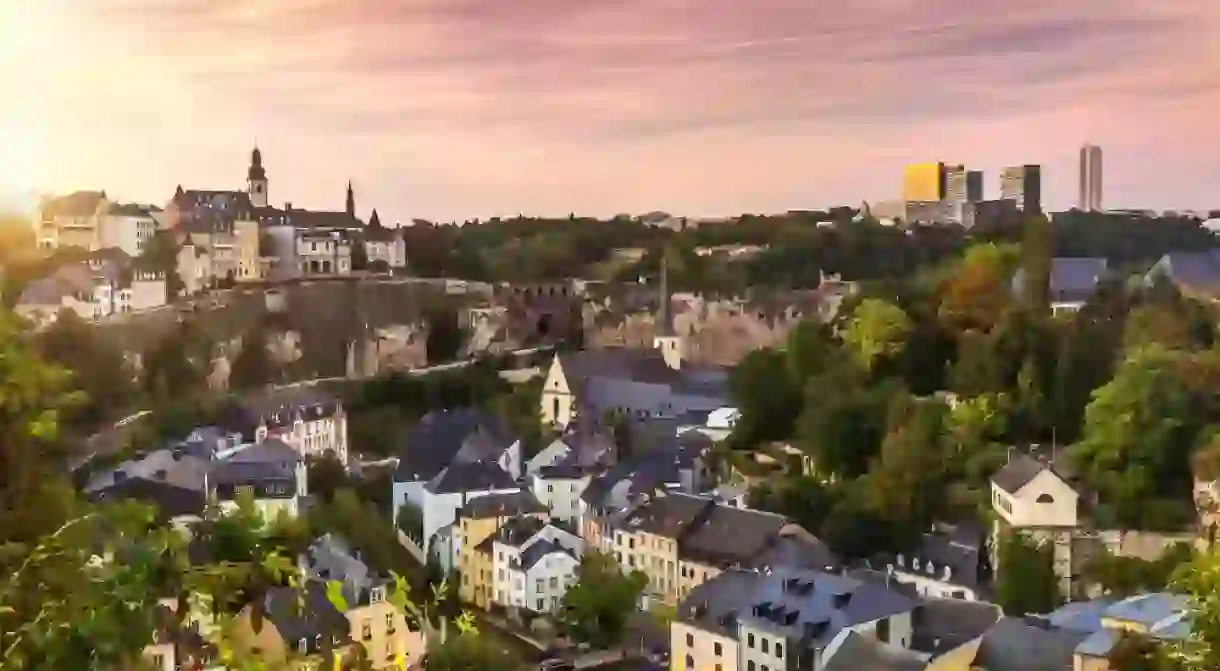The Most Impressive Buildings in Luxembourg City

From ancient constructions dating back to the 1500s to modern architectural marvels, the city of Luxembourg is filled with impressive buildings that make it a must-visit for architecture enthusiasts and history buffs alike.
European Court of Justice
Building

The European Court of Justice is the highest court in the European Union and is located in the Kirchberg Plateau, just east of Luxembourg City. Originally constructed in 1973, the building has undergone a number of facelifts and additions. The architect of the fourth extension, Dominique Perrault, explained his thought process behind the use of such a striking gold colour on the twin towers: “I thought the sky over Luxembourg is often so sad that it would be nice, somehow, to catch the sun and bring it here”.
Galeries Lafayette
Building
One of Luxembourg’s most impressive buildings isn’t, like so many others, an official government building or financial headquarter, but an homage to the art of shopping: Foster + Partners’ Galeries Lafayette department store. Located in the centre of Luxembourg, at the end of Grand Rue and Rue Aldringen, it’s the first building in a major mixed-used development by the architects. The building is meant to be ‘timeless yet contemporary’, and its undulating glass facade is an attention-drawing addition to the city’s town centre. Luxembourg’s newest department store also features a sky garden, complete with rooftop restaurant and bar.
Luxembourg City Hall
Building

Luxembourg City Hall (Hôtel de Ville de Luxembourg) was built in the 1830s by French architect Justin Rémont and made using materials from a deconstructed 13th-century Franciscan monastery, which stood in its place centuries before. The City Hall, located on Place Guillaume II, now serves as the centre of local government and is used as the private office of the Mayor of Luxembourg City. Its Neoclassical style has aged well, and the elegant building is still a worthy symbol of political power in the Grand Duchy’s capital.
Banque et Caisse d'Epargne de l’Etat
Building

This beautiful building, designed by architect Jean-Pierre Koenig and constructed in 1913, serves as the headquarters of the Luxembourg Savings Bank BCEE (Spuerkeess). The original building was too small, so an annex was added, followed by a second mounting in 1933. This impressive structure is located on Place de Metz and overlooks the famous Adolphe Bridge. Though it was built in the 20th century, the Savings Bank was designed in the Neo-Renaissance style that evokes the Renaissance period.
European Investment Bank
Building

In 2002, the European Investment Bank held an anonymous international competition for architects and designers who pitched their ideas for the bank’s east building. The competition was won by German architect Christoph Ingenhoven, whose design encompassed EIB’s philosophy of transparency and environmental stewardship. It was the first building in continental Europe, and one of the first in the world, to be awarded the UK’s BREEAM Bespoke ‘high environmental quality’ certification with a ‘very good’ rating.
Grand Ducal Palace
Building

Originally built in 1572, the Grand Ducal Palace (Palais Grand-Ducal) received a new wing in the 19th century and underwent a thorough restoration in 1992-1995. Today, the romantic building, which resembles a fairytale castle, is home to the Grand Duke of Luxembourg, but in the summertime visitors are welcome in to admire the grand interior, which combines rooms in palace-style splendour with modern touches like light design by Ingo Maurer.
Grand Duke Jean Museum of Modern Art
Museum

Located in the Kirchberg district, this impressive structure was erected in 2006 atop the ruins of an abandoned fortress and beside another. The museum, also known as MUDAM, was designed by Ieoh Ming Pei, the Chinese-American architect behind the glass pyramid at the Louvre. The building caused a great deal of controversy and strife within the Grand Duchy, due to its strikingly modern appearance. Although it is called a modern art museum, the budget did not allow for acquiring a modernist collection. Instead, MUDAM is home to contemporary art pieces by 100 artists, including Andy Warhol, Bruce Nauman and Julian Schnabel.
Notre-Dame Cathedral
Cathedral, Church

Like its French counterpart, the Notre-Dame Cathedral in Luxembourg is an eye-catching edifice. Constructed between 1613 and 1621, the Notre-Dame Cathedral (Cathédrale Notre-Dame) is the only cathedral in all of Luxembourg. Interior features include columns decorated with arabesques, stained glass from the 19th and 20th centuries and Neo-Gothic confessionals. The crypt within is the resting place of John the Blind, King of Bohemia, the Count of Luxembourg and deceased members of the Grand Ducal Family.
Philharmonie Luxembourg
Concert Hall

The Philharmonie Luxembourg, also referred to as The Grande-Duchesse Joséphine-Charlotte Concert Hall, is a concert hall located in the Kirchberg Plateau. This impressive building was commissioned in 1997 after Luxembourg was nominated as the European Capital of Culture, but had no concert hall, and was designed by French architect Christian de Portzamparc. He originally wanted to “plant a ring of trees which would be necessary to cross in order to enter the complex devoted to music,” but there wasn’t enough space and he settled instead for a striking design, with a peristyle made of 827 vertical lines constituting a foyer. The hall officially opened in 2005 and now plays hosts to nearly 400 performances each year.
Additional reporting by Cajsa Carlson













